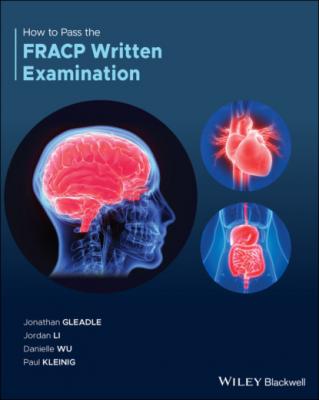How to Pass the FRACP Written Examination. Jonathan Gleadle
Читать онлайн.| Название | How to Pass the FRACP Written Examination |
|---|---|
| Автор произведения | Jonathan Gleadle |
| Жанр | Медицина |
| Серия | |
| Издательство | Медицина |
| Год выпуска | 0 |
| isbn | 9781119599548 |
Brugada J, Campuzano O, Arbelo E, Sarquella‐Brugada G, Brugada R.et al. Present Status of Brugada Syndrome. Journal of the American College of Cardiology [Internet]. 2018 [cited 16 November 2020];72(9):1046–1059. Available from: https://www.sciencedirect.com/science/article/pii/S0735109718353622?via%3Dihub
9. Answer: A
This presentation is highly suspicious for cardiac amyloidosis (CA). His echocardiogram suggests cardiac involvement especially left ventricular hypertrophy in the context of hypotension and low voltage ECG, which could be further investigated with cardiac MRI.
Amyloidosis is a collection of diseases in which a protein‐based infiltrate deposits in tissues as beta‐pleated sheets. In >95% of CA, the main protein being deposited is light chain [termed light chain amyloidosis (AL)] and less commonly transthyretin [termed transthyretin amyloidosis (ATTR)].
AL is a plasma cell dyscrasia, where misfolded antibody light chain fragments can deposit systemically in any organ. The typical presentation is heart failure with preserved ejection fraction, with pathognomonic but infrequent presentations with macroglossia and/or periorbital purpura, and other symptoms dependent on organ involvement, commonly kidneys (proteinuria, especially nephrotic range) gastrointestinal tract (diarrhoea, weight loss), and nervous system (peripheral neuropathy, carpal tunnel syndrome, orthostatic hypotension). AL presents in adults, with a median age of diagnosis of 63, and median untreated survival of 6 months if the initial presentation is heart failure. It is rare for patients to have clinical involvement of all of these organ systems. The diagnosis is often delayed. Physician should have a heightened clinical suspicion for amyloidosis in appropriate clinical context and should consider it until proven otherwise.
ATTR is due to monomerization and misfolding of the protein transthyretin, which is produced by the liver and functions as a transporter of thyroxine and retinol. There are two main subtypes of ATTR amyloidosis: (i) acquired wild type ATTR (ATTRwt, previously senile CA) which typically presents as heart failure or hypertrophic restrictive cardiomyopathy in a male >60, often preceded by carpal tunnel syndrome and/or spinal stenosis, and (ii) hereditary mutant variant (ATTRm) which can be due to >100 point mutations, and subsequently presents heterogeneously as polyneuropathy, cardiomyopathy, or mixed. ATTR prognosis is better than AL, with median survival of 4 years for ATTRwt and variable for ATTRm.
Echocardiogram is the first step in the CA diagnostic workup to identify patients likely to have the disease and prompting further workup. Typical features of CA on echocardiogram include:
Left ventricular hypertrophy in the absence of secondary causes
Mismatch between ECG finding of low voltage and echocardiogram finding of left ventricular hypertrophy
Granular sparking appearance of left ventricular wall
Apical sparing
Diastolic dysfunction
Biatrial dilatation and reduced left ventricular cavity dimensions
ECG hallmarks are low voltages. Further investigations include:
sFLC ratio and serum/urine immunofixation (to investigate for AL).
Cardiac imaging (non‐invasive diagnosis)Longitudinal strain imaging using 2D speckle tracking for ‘apical sparing’ patternCardiac MRI for diffuse and subendocardial ‘late gadolinium enhancement’ pattern that does not respect coronary distributions (93% sensitive, 70% specific)99mTcPYP scintigraphy for grade 2 or 3 myocardial radiotracer uptake (100% specificity and positive predictive value, in absence of monoclonal gammopathy)
Endomyocardial biopsy (diagnostic gold standard, 100% sensitive for CA).
Definitive diagnosis of amyloidosis requires biopsy (Table 1.3).
Table 1.3 Sensitivity of different organ biopsy in diagnosis of amyloidosis.
| Organ | Sensitivity |
| Abdominal fat pad | 70% |
| Bone marrow | 50% to 60% |
| Clinically involved organ | 99% to 100% |
| Rectum | 70% to 85% |
Donnelly J, Hanna M. Cardiac amyloidosis: An update on diagnosis and treatment. Cleveland Clinic Journal of Medicine. 2017;84(12 suppl 3):12–26.
https://www.ccjm.org/content/84/12_suppl_3/12.long
10. Answer: A
Cardiac output is defined by the amount of blood ejected by each ventricle in one minute. Cardiac output (litres/min) is the product of the stroke volume (litres/beat) and the heart rate (beats/min). There are four determinants of cardiac output, including heart rate, preload, afterload, and contractility.
Heart rate is affected by chronotropic factors. Sympathetic stimulation by noradrenaline, adrenaline, and medications such as atropine can increase heart rate. Activation of the parasympathetic system and chemicals, such as acetylcholine and adenosine, slows down the heart rate.
Preload is the amount of blood entering the ventricle during diastole, also known as the end‐diastolic volume. It is influenced by blood volume, venous return, and atrial contraction.
Afterload occurs during systole when ventricle contracts and ejects blood out of the aorta and into the pulmonary trunk. Atherosclerosis, peripheral vasoconstriction, and hypertension increase afterload due to increased resistance.
Inotropic factors affect the contractility of the heart. Positive inotropes such as sympathetic stimulation by noradrenaline and dobutamine increases cardiac output. The parasympathetic system, acetylcholine, beta blockers, acidosis, and calcium channel blockers can have negative inotropic effect on the heart and reduce cardiac contractility.
Atropine increases heart rate, causing a higher cardiac output. Adenosine slows down heart rate hence reduces cardiac output. Hypertension increases the force against which the ventricles must pump in order to eject blood, hence reducing cardiac output. Beta blockers have negative inotrope effect and also slow down the heart rate, resulting in decreased cardiac output.
Acidosis reduces left ventricle contractility. However, this is compensated for by an increased heart rate and a reduced systemic vascular resistance, resulting in an increased cardiac output.
Vincent J. Understanding cardiac output. Critical Care. 2008;12(4):174.
https://www.ncbi.nlm.nih.gov/pmc/articles/PMC2575587/
11. Answer D
Episodic loss of consciousness is most commonly
